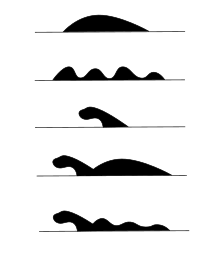Cryptozoology
Cryptozoology (ancient Greek κρυπτός kryptós "hidden, secret", ζῷον zóon "animal, living being" and λόγος lógos "lore") deals with animals for whose existence there is only weak and dubious evidence, such as folklore, legends, eyewitness accounts, footprints, and (usually blurred) photographs or films. Scientific zoology does not deal with such creatures; they are the subject of folklore and mythology. Cryptozoologists suggest that reports of animals normally classified as mythical creatures are in part due to as yet undiscovered species. Such a species is called a cryptid in cryptozoology. Cryptids should not be confused with cryptospecies.
Cryptobotany, which searches for man-eating plants, for example, and cryptozoology are sometimes combined as cryptobiology. Cryptozoology is subdivided into, among others, dracontology, which deals with water cryptids, i.e. sea monsters (e.g. Ogopogo or sea snake), hominology, which searches for ape-men such as Yeti and Orang Pendek, and mythological cryptozoology, which speculates on the origins of mythical creatures.
The term cryptozoology was coined in the 1940s and 1950s by Ivan T. Sanderson and Bernard Heuvelmans. Because of his central position, Heuvelmans is often referred to as the "father of cryptozoology." Even before the emergence of cryptozoology, others had worked on the subject, such as Charles Fort.
Outsiders classify cryptozoology as a pseudoscience. The International Society of Cryptozoology (ISC), founded in 1982 and inactive since about 2004, campaigned for cryptozoology to be recognized as a serious science. In the German-speaking world, the Verein für kryptozoologische Forschung took on this task from its founding in 2005 until its dissolution in 2008.

Distribution of alleged sightings of Bigfoot in 2009.
Cryptides
Cryptozoologists are known to search for large animals that, like mothman, chupacabras or werewolves, do not seem to fit into existing classification schemes. In addition, however, there are many cryptids that are supposed to be relatives of known species, such as Marozi and African pygmy elephant.
Cryptozoologists also follow up on traces that could indicate the survival of species considered extinct. So one hopes for the so-called Lazarus effect. In addition to dinosaurs such as Mokele-Mbembe, these include the pouched wolf and the moa. According to the prehistoric-survivor paradigm, which is widespread in cryptozoology, the Loch Ness monster, for example, is explained as a plesiosaur or basilosaurus.
Cryptids are also "normal" species when they are sighted in areas where they are not usually found. These so-called out-of-place sightings include alien big cats.
The Beast of the Gévaudan - a historical incident in southern France - can also be considered a subject of cryptozoology.

Schematic representation of the various forms in which the Loch Ness Monster is sighted.
Search within the encyclopedia